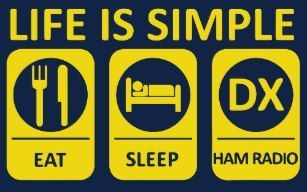Welcome to what I hope will be a monthly place to pass along tips and operating hints to newer hams. So many people do not have an electronics or electrical background so I hope to pass along things that might seem common to some but a revelation to others. If you have questions or things that you would like to see please drop me an email.
The first topic will be radio systems. All communications equipment is made up of several subsystems that combined allow you to “talk” to others. The major subsystems are: Antenna, Radio and Power. If you have heard another ham talk about how important a good antenna is to them, pay attention. The radio makes the signal, but the antenna puts the signal in the air to be received by others.
Most new hams today will start off with a portable or “Handitalkie”. This small box still has an antenna connected on top. It will work fairly well under most conditions BUT an external antenna will generally work much better. To connect the antenna to the radio you should have a good low loss cable. Signal is lost being transferred thru cable and that loss is measured in decibels (or db). The lower that number the better. Frequency also plays into how much signal is lost. As a general rule, the higher the antenna the better.
All radios have a similar function, create a signal to be transmitted or receive a signal and transform it back to something we understand. The output of the radio is measured in watts of power. Most handheld radios are lower power, 3-8 watts. Mobile radios typically will be of much higher power (5-80 watts) and a true full power (base) radio might be 20-100 watts.
In order to make that radio function it requires power. That power can come from a battery, power supply or straight from an AC outlet. HT’s use batteries that can range from 5-15 volts. Care for your battery properly and it will last you a few years. Don’t leave it in the charger, Take it out and use it or just leave it on the table. If you use it a lot recharge when needed. There are 3 basic types of batteries: alkaline, Ni-cad and Lithium ion. Alkaline batteries are used until they die, then dispose of properly. Ni-cad and lithium batteries can be recharged many times and reused. The newer Li-on batteries do not have a memory so they can be recharged when you are done using them. Ni-cads should be run down and then recharged.
This quick look just scrapes the surface on a LOT of things. Read articles on all of the subjects so you gain more knowledge! More importantly, ask questions. Most hams are more than willing to share information on a variety of subjects. Find the right person who knows a lot about what you want to learn!
73’s WA2NTW

